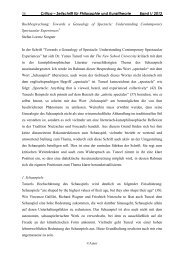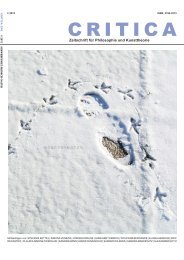Band II/ 2013 (7mb) - critica – zeitschrift für philosophie & kunsttheorie
Band II/ 2013 (7mb) - critica – zeitschrift für philosophie & kunsttheorie
Band II/ 2013 (7mb) - critica – zeitschrift für philosophie & kunsttheorie
Erfolgreiche ePaper selbst erstellen
Machen Sie aus Ihren PDF Publikationen ein blätterbares Flipbook mit unserer einzigartigen Google optimierten e-Paper Software.
CRITICA-ZPK<br />
<strong>II</strong>/ <strong>2013</strong><br />
hearing, of feeling what one sees<br />
and hears, of comfort and discomfort<br />
are engraved and cause permanently<br />
new perceptions. The body is<br />
the shrine of life, centre of mysticorgiastic<br />
experiences.<br />
Following tradition, the shrine is the<br />
smallest dwelling for body particles<br />
of saints. Accordingly, its outside<br />
is lavishly equipped. ln the Middle<br />
Ages, the shrine often takes the<br />
form of the preserved relic, becomes<br />
arm, foot or head of the worshipped.<br />
Paul Thek follows this tradition with<br />
the series of “Technological Reliquiaries”.<br />
Under the impression of<br />
Capuchin catacombs near Palermo<br />
where the well maintained dead bodies<br />
“decorate the walls like blooms”,<br />
Paul Thek produces Meat Pieces<br />
which are presented in remarkably<br />
arranged acrylic glass boxes. The elegant<br />
forms of the minimal shrines<br />
are in contrast to their content, hyper-realistic<br />
meat pieces which in<br />
contrast to the medieval ancestors<br />
cannot be referred to someone particular.<br />
These amorphous pieces of<br />
raw meat consisting of wax do not<br />
even remind of a particular part of<br />
the body. In Meat Piece with Warhol<br />
Brillo Box, 7 Warhol’s cult object of<br />
Pop Art is degraded to a showcase.<br />
Only the top side displays the famous<br />
writing, as if one looked into<br />
it from below. The meat piece in the<br />
showcase resembles a cut through<br />
blood vessels as we know them from<br />
anatomical books. lt is not dead matter<br />
but living flesh accusing the culture<br />
of Pop Art which intentionally<br />
fails to see the creativity in the human<br />
being. In this trendy Reliquiar,<br />
7 Paul Thek, Meat Pieces with Warhol Brillo<br />
Box, series Technical Reliquiaries, 1965,<br />
wax, silk-screen printing on acrylic glass,<br />
35.5x43x43cm, Philadelphia Museum<br />
of Art, illustrated in: Alexander Braun,<br />
Die wunderbare Welt des Paul Thek, in:<br />
Kunstforum International, Die Zukunft des<br />
Körpers I, Vol. 132, Nov.-Jan. 1996, p.232.<br />
the fragment of the body seems like<br />
a foreign body, a relic from the past<br />
which is preserved as curio because<br />
it is so rare. But even in the hiding<br />
of the Brillo Box, the presence of the<br />
relic can stand its ground.<br />
The shrine and the meat preserved<br />
therein refers to the immanence of<br />
life also beyond death. This is the<br />
only way to understand The Tomb 8 . In<br />
the interior of a pyramid lies a lifesize<br />
replica of wax of Thek stretched<br />
on the floor. Next to the dead body,<br />
some cult objects. The two cut off<br />
fingers of his right hand hang ostentatiously<br />
on the wall. Also the<br />
blue-colored tongue refers to a violent<br />
death. The cause remains unclear;<br />
has the artist cut off the fingers<br />
to punish himself in a lunatic<br />
gesture like van Gogh, or is he victim<br />
of his curiosity like in Umberto Ecos<br />
novel The Name of the Rose? Nobody<br />
knows it, even less the visitor of the<br />
tomb who looks at the dead body<br />
in a lonesome confrontation. Alexander<br />
Braun 9 writes: “The dialog<br />
in The Tomb takes place on a largely<br />
equal recipient-work-level, quasi of<br />
entire corporeality to entire corporeality<br />
[an element connecting the<br />
work of Thek with those of Nitsch].<br />
…The scenario is determined by a<br />
pink-colored atmosphere which not<br />
only derives from the paint of the<br />
pyramid but also from the particular<br />
type of illumination. Together with<br />
the work, the onlooker is caught in<br />
a special color-room-continuum…<br />
The specific color has spread to the<br />
dead body and its clothes. Body and<br />
surrounding area blend with each<br />
other and become [together with the<br />
recipient] part of a common consciousness.”<br />
This way, the dead body<br />
8 Paul Thek, The Tomb, 1967, wood, wax figure,<br />
295x320x320cm, installation Stabble Gallery,<br />
New York, illustrated in: Kunstforum, op.<br />
cit. , p. 237.<br />
9 Op. cit. p.238.<br />
is presented as having died, not as<br />
being dead. lt has entered another<br />
form of life which is understood as<br />
continuum of this world. Referred<br />
to art, this means: “The artist is dead,<br />
long live the artist!” This does not<br />
refer to the monarchy where the old<br />
monarch abdicates and his successor<br />
is paid honor, but it means the<br />
continuance of the aura in the work<br />
beyond physical death.<br />
Only rarely does the building of<br />
a house manifest the intention of<br />
a sculptor to make art, even more<br />
rarely does its permanent alteration<br />
of the outside and inside become<br />
a material component of the plastic<br />
creation. The Frenchman Jean-<br />
Pierre Raynaud dedicates twenty<br />
years to the building and rebuilding<br />
of his own dwelling. lt becomes<br />
a permanent experimental field, an<br />
ontic adventure to find his own human<br />
and artistic identities. When<br />
Jean-Pierre Raynaud begins to build<br />
his Maison in 1969, he has already<br />
built several models in the course of<br />
his psycho objects.<br />
As the title of this group of works<br />
indicates, the objects paint a mental<br />
picture of the artist, his fears, the<br />
growing need for protection arising<br />
from it through violent defense<br />
or insulation. ln connection with<br />
Psycho-Object. Maison of 1963, Jean-<br />
Pierre Raynaud speaks of a house<br />
which as original of La Maison was<br />
tailored to the dimension of a life,<br />
his life, that means of a serious decision,<br />
a definitive commitment<br />
which completely absorbed him and<br />
left only few loopholes. 10 The visitor<br />
10 The exact quotation is as follows: La<br />
maison était comme la maison (qu’elle<br />
préfugerait) à la dimension d’une vie, de<br />
ma vie, c’est-à-dire une décision grave,<br />
un engagement définitif, un choix qui<br />
m’implicait totalement et dont les portes de<br />
sortie étaient et sont encore actuellement<br />
rares. 1986, Interview by Maiten Bouisset, in:<br />
7




